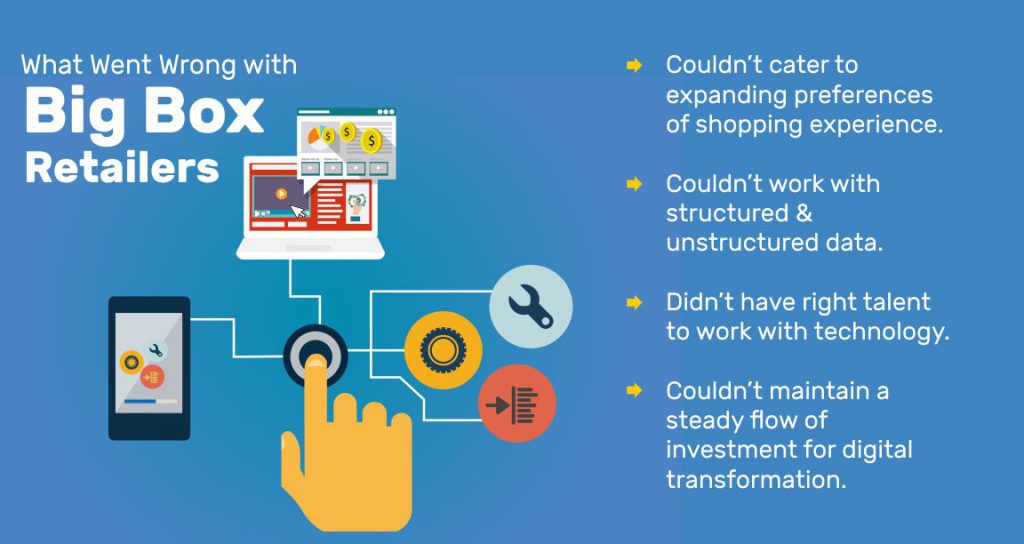Retail Digital Transformation Challenges
What Went Wrong with Big Box Retailers?
Payless, another big box retailer, filed for bankruptcy for the second time on February 15. However, this time the brand made its intentions quite clear. It was closing down all of its 2,100 stores in the USA and Puerto Rico. But that’s not all. They also shut down their e-commerce website.
READ MORE
What Payless teaches us is that having an ecommerce website and a digital business model is not enough. Despite having all the necessary digital tools in place, a retail brand can still fail in this age of digital transformation.
2018 has witnessed a lot of big retail brands getting not just disrupted but also uprooted from their markets altogether. It has shown that just making large investments in digital technologies is not enough. You also need a strategy in place to tackle the challenges that come with digital transformation.
Here are some challenges that give retail leaders sleepless nights.
 Expanding Preferences for Shopping Experience
Expanding Preferences for Shopping Experience
Today customers prefer a wide variety of shopping experience. Some prefer to walk into the store, touch and feel the product, and then make a purchase. Some customers prefer online shopping. Then there are those who want to shop online but pick up the product at their own convenience. There are also customers who expect a trial room experience on their mobile app using AR and VR solution.
The real challenge is not how to deliver these preferred shopping experiences. It lies in identifying what a particular customer prefers. This is where we come in. We work with retail brands to help them understand their customers intimately. We help them preempt customer preferences and plan their engagements accordingly.
We help them integrate customer engagement strategies with the digital tools they have in place and help them optimize both.
Humongous but Unstructured Data
Retail brands are sitting on a treasure trove of data. In fact, every single customer interaction generates information. And when you add the digital touchpoints to the mix, it just amplifies the value of the information. However, where retail leaders really struggle is in converting this information into intelligence.
They invest in big data solution. But the disparity in the data captured makes it difficult to analyze it. The lack of uniformity and structure means it is difficult to combine data from multiple sources to get a more realistic view of the customers and business.
Some solutions only work with structured data which means the information sitting in unstructured data is either wasted or lost forever.
We tell our retail clients that just implementing a big data solution is not going to work magic tricks for them. We work with them at grassroot level to streamline the way data is captured and stored so that meaningful data analytics can be applied.
Too Many Tools but Not Enough Talent
Many people make the mistake of believing that digital transformation is all about adopting new tools and technologies. They tend to forget that you also need people to man these technologies.
Many retail brands are moving towards a self-service environment that will be powered by multiple tools. But they do not have the people who can work in this self-service environment. Their existing workforce is just not ready for a working space dominated by the multiple technologies or an omni channel environment. They lack the skills and experience needed for such dynamic environment.
As a digital transformation partner, we insist that our clients make HR and talent development their top most priority. We work with them to create a strategy that would upgrade the skills of their existing people through appropriate training.
We also help our clients identify the new skillsets that they would need within their organization. These skills cannot be developed in-house and need to be sourced. These are niche functional roles that are created by digital transformation and require special talent.
Insufficient ROI from Digital Investments
Any digital initiative requires investments. Retail leaders know that they have to invest money, time, and resources in digital transformation. But the pace of transformation is so fast that they hardly get any time to settle down with the new technology and showcase a meaningful ROI from it. For CIOs and CTOs justifying the digital investments becomes a challenge.
Digital innovation has to become a strategic objective and people at all levels are expected to contribute to it. When you have all this going into digital transformation, it also becomes imperative to showcase an impressive ROI. But the ROI of digital transformation investments has to be approached differently.
When we work with our clients, we help them prepare for that initial phase where the returns are going to be absolutely nil. We help them build a business case to seek a continuous and steady flow of investments during this phase. We also work with them to create a strategy that shows the value of digital transformation during that initial phase before the executive board really starts seeing some tangible returns.
Conclusion
We believe the recent upheaval of the retail industry was a disaster in the making for the big box retailers. Some of them adopted an ostrich mentality and buried their heads in the ground hoping to ride away the wave of disruption. While others did make efforts to embrace digital, they did it with a strategy that was fraught and incomplete.
Do not make the same mistake. Before you get ousted by your competition, get your digital transformation plans in place. Talk to us about your digital transformation plans and we can help you create a strategy that secures your investments as well as bring real value to the table. We can help you address the challenges that became the nemesis of some revered names of the industry.
Contact Us

